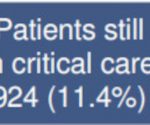Covid-19 is pneumonia – everything else is lies
Apparently, for corporate and alternative media both, ICNARC – which is the Intensive Care National Audit and Research Centre – is invisible, presumably because of the very inconvenient substance of the material that it produces. Since the start of the fake pandemic, ICNARC have been presenting reports on intensive care unit (ICU) occupancy, in England, Wales and Northern Ireland, of so-called “Covid-19” patients.
The latest such like report states that there are currently 358 people in critical care – i.e. in an ICU – with an illness deemed to be Covid-19. Forget case numbers, which some Winston Smith sitting in the bowels of the Ministry of Truth is undoubtedly inventing, this pathetically small amount of Covid-19 ICU patients in England, Wales, and Northern Ireland most properly represents the state of any so-called pandemic.
Indeed, in the entire course of the fake pandemic, 37,503 patients were admitted to ICU with what was diagnosed as Covid-19 and, of those, 14,269 died in ICU, while another 1,244 died after being discharged into acute hospital. This tells us that about 1000 people died per month of real Covid-19, because as has been explained before in these pages, real Covid-19, or Severe Acute (rapid onset, short course) Respiratory Syndrome 2 as it would be more useful to call it, requires intensive care treatment. ICNARC data, then, as consistently explained in these pages, is the best indicator of death from real Covid-19, and indeed the real extent of the virulence of the disease. The data clearly shows that Covid-19 is clearly not the contagious disease that it is made out to be – hence the accusation that the pandemic is fake (and hence why ICNARC is invisible to controlled alternative media). [Contrast 15,513 “Covid-19” deaths in 15 months – 12,410 in one year – to 616,014 all cause deaths in the UK in 2018, with 286,000 deaths in NHS care in the same year (see Dr Strangelove: Or How I Learned To Stop Worrying About The Sale Of The NHS – link)].
Moreover, a research paper newly discovered by the author indicates that Covid-19 is not even as common as the ICU data suggests it is, and it does so because it illuminates a mistake that is being made by doctors when understanding why a patient is having the symptomatic respiratory difficulties when they are diagnosed as being ill with Covid-19. The paper in question is authored by Dr Pierre Kory and Jeffrey P Kanne, the former being of Aurora St Luke’s Medical Center, Milwaukee, Wisconsin, and the latter of University of Wisconsin–Madison. Published at the BMJ Open Respiratory Research website (where there doesn’t seem to have been the interest there should have been in it). The paper is a year old, so it comes from a time when there hadn’t yet been the complete loss of touch with the facts of the disease as it first was understood – which is welcome at this time when disinformation in alternative media makes claims about “vaccine” reproducing Covid-19 in the blood – a complete nonsense.
The paper is entitled, SARS-CoV-2 organising pneumonia: ‘Has there been a widespread failure to identify and treat this prevalent condition in COVID-19?’ And it reminds that when it was first “discovered” in China, Covid-19 was called novel coronavirus-infected pneumonia – NCIP.
As the FBEL reader will know, the fact of Covid-19 as pneumonia has been reported consistently in these pages ever since the author first did what alternative media cannot seem to do and investigated what the medical papers were saying about the disease. What quite couldn’t be found out was how the exactly the physical mechanics of Covid-19 – the binding of SARS-COV to ACE2 at the lung – translated into pneumonia – not until the author found the paper out of Milwaukee.
To appreciate why the paper is the crucial piece in the puzzle one must know about what quickly became the received thinking when the West first started to have its own NCIP experience – or, as the truth probably has it, when persistent, but re-designated SARS was identified where it had been lurking as a now run of the mill illness all along. Written in fact from the American perspective, where the phenomenon of hypoxia associated with the disease was a thing noted (unlike, seemingly, in the UK), it was the case that a symptom of respiratory illness would confirm a diagnosis of “Covid-19” (in quotation marks because it wasn’t necessarily a case of the disease), or indicate a new case, and ventilation – particularly on the industrial invasive end of the scale – would be the standard first instance method of dealing with the condition. This received thinking is why there was the initial flap about there not being enough of the right sort of ventilation equipment at the start of the travesty. The idea quickly became established that Covid-19 was essentially a condition like Acute Respiratory Distress Syndrome (ARDS), if not actually possessing a quality of ARDS, because ARDS follows from infection in the lung. ARDS can be caused by other things, of course, and the trick of “Covid-19” would count on having these other cases – that weren’t real Covid-19 – counted as being such.
Now, the paper out of Milwaukee is important because it posits that the course of Covid-19 is not like ARDS, and it also presents a conclusion that validates what that this site has told its readership about real Covid-19.
The paper points to what was a puzzle about the hypoxia in these ARDS-like cases, which led to a new classification of that particular syndrome when patients were responding differently to the ventilation treatment.
From the earliest reports of the novel virus SARS-CoV-2 causing a respiratory illness (COVID-19), clinicians remarked on the puzzling discordance between the degree of hypoxemia and relatively modest work of breathing observed. Early reports described this combination as ‘silent hypoxemia’ and such patients as ‘happy hypoxemics’. Similarly, soon after mechanical ventilation was instituted, unexpectedly high degrees of lung compliance in conjunction with severe hypoxemia was deemed a new ‘L’ phenotype of acute hypoxemic respiratory failure, attributed to an early phase ‘dry lung’ with measured ‘hyperperfusion of gasless tissue’ as opposed to the significant alveolar oedema and resulting hypoxic vasoconstriction observed in ‘traditional’ acute respiratory distress syndrome (ARDS).
The better explanation, said Kory and Kanne, was organising pneumonia, which is a condition when tissue growth (for a simple picture) fills the alveoli (lung parts for transmission of oxygen to the blood) and bronchioles (passageways for air in the lung). The authors of the paper point to CT scanning of early NCIP/Covid-19 patients, and indeed autopsies where the material could be evidenced (and note, neither of these methods appears to have been used in the UK to filter a proper case of Covid-19 out from everything else).
We believe that clinicians have not sufficiently considered the condition of ‘viral-induced secondary organising pneumonia (OP)’, largely due to the fact that OP in its idiopathic form, called cryptogenic organising pneumonia (COP), is a rare and clinically unique disease often misunderstood and poorly recognised even by pulmonologists. OP is a histological pattern of lung injury characterised by the filling of alveoli and alveolar ducts with spindle-shaped fibroblasts and myofibroblasts that later form granulation tissue…
The most compelling support for OP as the underlying pattern of lung injury from COVID-19 comes from an expert panel review, published in March 2020, which reported “the most common reported CT findings in COVID-19 patients are typical of an organizing pneumonia pattern of lung injury”, with this pattern now described in virtually all published cases.
With this information, one can understand a certain amount of futility in ventilation because in ARDS the purpose is to keep alveoli open, thus (presumably) functional. In Covid-19, they are filled with tissue and blocked. That which is required to be caused by ventilation can therefore surely not occur.
In another way of creating understanding of a distinction between ARDS and Covid-19, the paper talks about treatment by a drug, and in doing so creates comprehension of why it was that certain drugs became famous by reputation for use to treat “Covid-19”. The paper itself only identifies the drug dexamethasone for the treatment of organising pneumonia. Of course, what happened in the history of Covid-19 in the English-speaking world was a huge misunderstanding– whether it was planted or just taken up by a horde casting around for solutions – that certain drugs could be used for “Covid-19” or, in other words, every different medical condition that could be misidentified as the real thing. Certainly, treatment by pharmaceutical drugs was a talking point which aided the impression that Covid-19 was rampant. The truth was that a very specific treatment could be applied to a very specific condition – which would even negate the requirement for ventilation, ultimately indicating something very different from the faux disease in its most plausible form (ARDS).
Now, the paper doesn’t mention it, but at FBEL we must recognise the lung damage as being the SARS-COV to ACE2 binding that was causing the fibrosis that the Chinese were seeing in their CT scanning of NCIP patients. And so, it becomes clear that the SARS-COV to ACE2 binding is the organising pneumonia. Real Covid-19, dear reader, is pneumonia.
And Covid-19 is the same disease as SARS – the only difference appears to be capacity to create damage, as noted by the Milwaukee researchers:
With SARS, OP and its histological variant, acute fibrinous and organising pneumonia (AFOP), were reported in 30%–60% of intensive care unit patients. The reported CT findings of COVID-19 suggest that secondary OP, AFOP or both may be occurring even more frequently.
A higher frequency of OP and AFOP in Covid-19 would possibly be due to a better capability to bind with the ACE2 protein on endothelial cells on the walls of the architecture of the lungs, although to say this, one should really prove that there isn’t a difference between pre-2010 and current levels of ACE2. If they are generally higher in a population, then it could be that there is a more conducive terrain for the condition, and no difference in the SARS pathogen.
And higher ACE2 levels could just be a simple case of more usage of pharmaceutical drugs intended to treat hypertension and related diseases which are known to create higher expressions of the protein. In fact, very recently batches of certain Angiotensin-II Receptor Blocker (ARB) drugs were withdrawn from use – and done so all very quietly. Related to this is the development in narrative whereby statins have been claimed as being effective in treating “Covid-19” by some interaction or other (the author hasn’t looked into it) with ACE2. It could mean that the pharmaceutical industry is attempting a straight swap because there has been a tendency, perversely, to promote Angiotensin-Converting Enzyme Inhibitors (ACEIs) and ARBs as “Covid-19” cures along the same lines. This is all material for another article.
To finish this one, the reader’s attention must be drawn to a different, and more current paper (March 2021). that the author was researching in conjunction with the Milwaukee one, that provides confirmation – unwittingly perhaps – that Covid-19 is not ARDS. It also, in the same fell swoop, validates another piece of information regarding the nature of Covid-19 as told of in these pages. The paper is called Severe covid-19 pneumonia: pathogenesis and clinical management, and is published by the BMJ proper, and there is some nonsense in it, such as a confession of induction into the faith of asymptomatic transmission. However, if the author can be excused for picking and choosing, the pertinent part that is reproduced below firstly relates how immune over-reaction is now doubted as being a cause of organ architectural deterioration in a Covid-19 patient – as per the case argued at FBEL, where the readership has been told that this immune response is one due to the pneumonia, and for a lead to begin seeing how and where this was done, please see the articles listed as 2 & 3 at the foot of the page. The following is from the aforementioned paper:
Early descriptions of covid-19 included development of a cytokine storm as a harbinger for clinical deterioration…. More recent studies comparing serum cytokine measurements with other known cytokine mediated diseases such as sepsis and cytokine release syndrome have noted that covid-19 patients’ serum cytokine levels were substantially lower. As a result, the direct role of cytokines in disease pathogenesis has been challenged. Many unanswered questions related to the pathogenesis of inflammation and the mechanism of action of corticosteroids in covid-19.
Autopsy studies of patients who have died from severe SARS CoV-2 infection reveal presence of alveolar wall injury and diffuse alveolar damage consistent with ARDS. However, compared with classic ARDS, autopsy studies also indicate higher thrombus burden in pulmonary capillaries, which suggests a greater pathogenic role of thrombotic and microangiopathic vasculopathy in covid-19 related ARDS.
Covid-19 related ARDS is not Covid-19 – and herein lies one of the main constructs of the big deception. What is being described† is the organising pneumonia that makes the condition different from ARDS. In fact, the authors of the Milwaukee paper are also slightly off the mark by understanding the organising pneumonia to be a feature of Covid-19, rather than its all encompassing quality, and they make what is actually a soft conclusion whereby “SARS-CoV-2–induced secondary OP, AFOP [acute fibrinous and organising pneumonia – a variant] or both is the underlying cause of COVID-19 respiratory disease in the majority of patients”. But then, this is perhaps understandable from an orthodox position, because if Covid-19 is “a rare and clinically unique disease often misunderstood and poorly recognised even by pulmonologists” – which is what Kory and Kanne call organising pneumonia (“in its idiopathic form”) – then how does one explain the millions of cases globally, and the hundreds of thousands of deaths.
Well, the answer is fraud, of course. The pandemic isn’t real. Covid-19 is rare, and should be called SARS-2 (or even 3), variants are irrelevant because the bottom line is how much ACE2 is sitting on the walls of the lung, and Winston Smith invents all the UK case number data, and the best word for describing a test for “Covid-19” is “random”, and NHS phone apps can be programmed to ping hordes into self-isolation just for the hell and the show of it.
If people who should know better are still doing it (and they are), it really is time to stop allowing for the paradigm; stop reacting to it, thinking and behaving as if it were real: stop giving power to it, either directly or through “opposition” that never fails to support it. There’s only one real thing about Covid-19 – and you’ve been shown it again here today – and it would collapse the whole scam if it got out. That’s why it doesn’t get out. Blame your controlled alternative media, and blame yourself for keeping it.
† Assuming that the autopsy study patient has died of the real disease. Remember how organising pneumonia “is poorly recognised even by pulmonologists”.
Further reading:
1- The Beneficent NHS, Where Corporate-Government Makes A Buck From Population Control (link)
2- Covid-19 And Pneumonic Immune System Overreaction (link)
3- A Twitter Encounter With A Zealot From The Cult At The Forefront Of Tyrannising The Country (An Equivalent Of The Nazi SS) (link)
4-More On ACE2: Some Truth In A Time Of Frenzied Controlled Opposition Alternative Media Hysteria-Stoking Misdirection (link)



















Have been following you since the outset and always find your writings challenging and stimulating! Question: is there SARS-Cov2 ? Is there a Covid-19 ? Is it necessary to cede ground to “exists, but rare” when there are no deaths that cannot be attributed to the usual causes ?
But there are some deaths that can be attributed to the CALL-IT-WHAT-YOU-LIKE-BUT-I-CALL-IT-SARS-COV binding to ACE2 that causes connective tissue growth in the lung (the very thing that the corporate and alternative media must be under strict orders not to discuss on account of how it can be caused by common or garden hypertension drugs pushed by the beloved NHS to create pharmaceutical drugs dependency sickness – like with the “vaccines” – which is actually the critical issue here).
It’s the same disease that was called SARS at the turn of the century, it’s probably been knocking around ever since. Deaths from SARS1 were in the hundreds – in the whole world. Exists, rare, nothing to worry about for 99.whatever%. To recognise this doesn’t disqualify the fact that a hoax has been hung on an otherwise innocuous illness. It makes sense that it would be executed that way, for compartmentalisation; i.e. some doctors on the coal face will be seeing the real thing, once misconstrued as one thing, now understood as another, while in another place, some people will actually be having cancer, flu, broken leg, etc, all called “Covid-19”.
Calling the real disease by its previous name, SARS, is actually quite helpful, so it could be said that SARS exists, but Covid-19, in quotation marks or otherwise, doesn’t.
Feeding the (big pharma) monster ?
a Nurse who works in the ICU of a large city hospital (uk), informs me that the vast majority of Covid ward cases are those with ongoing health problems, nothing new there, but also include an unusual amount of patients receiving anti-depressant medication.
I see that ACE2 is a key regulator associated with Angiotensin I/II ,a decrease in ACE2 activity causes a weakening of it’s ability to break down the ANG II protein, thus causing excessive inflamation and…damage to the body.
I see that medicines are used that act on the renin-angiotensin system (RAS) – angiotensin-receptor blockers (ARBs) – angiotensin-converting enzyme inhibitors (ACE-inhibitors) and direct renin inhibitors, and also read that the renin–angiotensin system is a target for the treatment of depression.
All a meaningless coincidence ?… or if Pharmaceutical Drugs were Ice, would they be the unseen danger beneath the cold waterline ?
Once again, Much Thanks.
Very revealing stats.
If we now have about 1500 deaths reported on the Yellow Card System and, as with other medications, only 10% of serious adverse reactions and deaths are reported, it seems to appear that there has been roughly the same amount of deaths both from COVID-19 disease and the vaccines that are claimed to offer some protection against it!